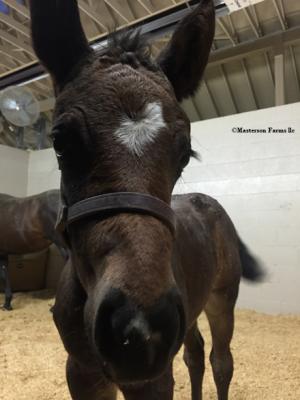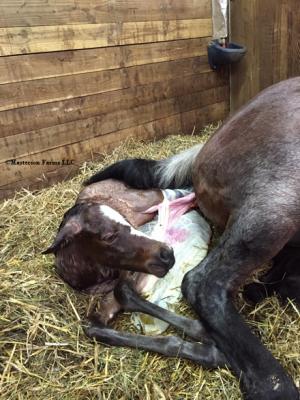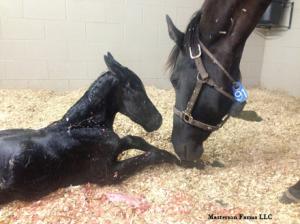January through June is a busy time of year at Masterson Farms, where stallion collection and semen processing, foaling mares, artificial insemination, embryo transfers and foal care are all happening simultaneously. The team effort of Farm Manager Amanda Ringer, Attending Veterinarian Dr. Colin Anderson, and Resident Veterinarian Dr. Hope Burge keep the busy schedule running like clockwork.
The folks at Masterson Farms take all precautions possible to ensure that foaling is safe and healthy. Mares are monitored closely during the last month of pregnancy. Two electronic devices, the Foal Alert and the Breeder Alert, as well as cameras mounted in the stalls are used to signal when the mare is in labor. A foaling cart with everything that might be needed for both the mare and the foal is wheeled to the stall as soon as the mare starts to deliver. There are towels; foal blankets; medical supplies for the mare if she is having problems; medical supplies for the foal if he/she is in distress. “It’s essentially a crash cart for troubled labor or dystocia (the medical term),” said Dr. Anderson. “We have a foaling checklist of things that we do and monitor for the mares and the new foals. Following are the guidelines.
Before Foaling: (1) Give a series of Equine herpes virus vaccinations (one approved for pregnant mares) at 5, 7, and 9 months of gestation. Equine herpes virus can cause late term abortion in the mare. (2) Within 4 to 6 weeks of the due date, the pregnant mares are given all annual vaccinations. “We think that the antibodies produced in response to the vaccines may get produced in the mare’s colostrumand thus benefit the foal as well. The foal survives on the mother’s immunity for about 3 to 6 months of age (average 4 months), until they start to build their own antibodies. This is a way to help protect the foal from infection,” Anderson said. (3) De-worm the mare to decrease the amount of parasite eggs that the foal could potentially ingest early in life. This can be done within two weeks of the due date. (4) Check mammary development within the last 60 days of the pregnancy. “If there are no signs of milk production within the last month there are options for treatment” Anderson recommended. (5) Within 2 weeks of the due date, if the mare has a Caslicks, remove it at this time. A Caslicks is a surgical procedure where a section of the vulva is sutured together to prevent ascending infection. If you do this at the beginning of pregnancy, then you want to remove it before foaling because you don’t want the mare to tear,” Anderson explained. The Caslicks procedure was developed by E. A. Caslick, DVM, to help protect against infection. One of the most common sources is contamination of the vagina by fecal material that drops into the vulva. This contamination can cause vaginal infection, which can spread to the uterus. (6) Use of a Foal Alert or Breeder Alert if available, which is put on the mare about two weeks before the mare’s due date. “ These devices will send out a signal or alarm to alert us that the mare is in labor and is a critical part of our monitoring program here at the farm”, Dr. Anderson stated. (7) Foaling time predictor kits can also be used. “These are handy,”
said Anderson. “We have found them to be really reliable when the mare is close to foaling.”These tests use the mare’s milk to try and predict how close the mare is to foaling.
At Foaling: (1) When the mare is close to foaling, wrap her tail. This prevents contamination. (2) Clean the perineal area and the udder. This possibly prevents the foal from picking up as many parasite eggs and bacteria. (3) Every mare owner should know what a normal presentation looks like (above) and consequently, an abnormal presentation. Charts are available that clearly illustrate this. “For a normal presentation, you want to see a clear/translucent amniotic sac; two front legs; and know that the head is between the legs,” Anderson explained. “If you see a red sac, this indicates premature placental separation – the placenta is coming first or with the foal. It is important to call the veterinarian, and you will need to tear the placenta or the foal can suffocate. The foal can tear the amniotic sac easily, but not the placenta. Unfortunately, this is an occurrence in west Tennessee because of endophyte infected fescue. The endophyte infected fescue can also cause agalactia, no milk production, and also prolonged gestation (time that is mare is pregnant).” (4) If you have an abnormal presentation, call the veterinarian immediately! With horses, there are usually no “simple” complications with foaling. If there is a problem it is almost always serious and can be severe and life threatening to the mare or foal; often both. Anderson continued, “Sometimes the veterinarian can talk clients through correcting some problems while he/she is on the way. Time is a huge factor! Foaling takes about 20 to 30 minutes; if 45 minutes have elapsed and the foal is still not born, you may be losing the foal.”(5) Depending on your experience, it is a good idea to call your veterinarian as soon as the mare starts foaling, or better – give your veterinarian a “heads up” that the mare is close to foaling. “Be very proactive,” Anderson recommended. “Don’t delay! Timing is critical!”
After Foaling: (1) The foal should stand within the first hour. Most stand within the first 10-15 minutes. If the foal is not standing within an hour, call your veterinarian. (2) The foal should nurse within the first 3 hours; often it is within the first hour. If not, call your veterinarian. (3) The mare should pass the placenta within 6 hours of foaling. “If the mare foals in a stall, tie it up so the mare is not stepping on it and so she doesn’t tear it,” Anderson recommended. “You don’t want the mare to retain any part of the placenta. Even a tiny piece can cause a mare to become very ill,” Anderson said. (4) Dip the umbilical stump (a source of neonatal infection) with dilute chlorhexidine solution or providone iodine solution. Just put it in a small cup and dip the stump. It is important to do this within the first 24 hours. (5) The foal should pass the meconium, the mucous plug, aka the first bowel movement, in the first 2 to 3 hours of life. They usually pass it after they nurse. If they don’t, the foal will have discomfort, signified by flagging and wrenching the tail. In this case, the foal may need an enema. (6) The foal must get adequatecolostrum – very important! This is the only immunity the foal has at first. To make sure the foal gets sufficient antibodies, check the IgG level in the foal’s bloodwithin 12 to 24 hours of delivery.
This test can even be done on the farm with a simple snap test kit. The reading should be >/= 800 mg/ deciliter. If the reading is <800, you can supplement with plasma (an additional source of equine antibodies administered intravenously through a catheter). (7) A physical exam by a veterinarian is performed on all foals within the first 12 hours. “If there are any abnormalities with the foal, it is very important to be proactive and try to get them corrected as early as possible,” Anderson said.
Handling the Newborn Foal: At the farm we try to start handling and working with the foals as soon as possible. Depending on the weather,the foals are usually around a week old when they go out in a paddock with the mare, where they can make friends with foals in adjoining paddocks. Then after a few weeks, they go out in a larger pasture with their “buddies.”
By the time the January babies are weaned in June, the foals are halter broken, can lead in and out of the barns, can be caught in the pasture, can have their feet trimmed, current on all their vaccinations, and then go out in a pasture with other weanlings to play. It’s a reliable, well-planned, organized system that keeps foals healthy, safe, and easy to handle from day one at Masterson Farms.
The folks at Masterson Farms take all precautions possible to ensure that foaling is safe and healthy. Mares are monitored closely during the last month of pregnancy. Two electronic devices, the Foal Alert and the Breeder Alert, as well as cameras mounted in the stalls are used to signal when the mare is in labor. A foaling cart with everything that might be needed for both the mare and the foal is wheeled to the stall as soon as the mare starts to deliver. There are towels; foal blankets; medical supplies for the mare if she is having problems; medical supplies for the foal if he/she is in distress. “It’s essentially a crash cart for troubled labor or dystocia (the medical term),” said Dr. Anderson. “We have a foaling checklist of things that we do and monitor for the mares and the new foals. Following are the guidelines.
Before Foaling: (1) Give a series of Equine herpes virus vaccinations (one approved for pregnant mares) at 5, 7, and 9 months of gestation. Equine herpes virus can cause late term abortion in the mare. (2) Within 4 to 6 weeks of the due date, the pregnant mares are given all annual vaccinations. “We think that the antibodies produced in response to the vaccines may get produced in the mare’s colostrumand thus benefit the foal as well. The foal survives on the mother’s immunity for about 3 to 6 months of age (average 4 months), until they start to build their own antibodies. This is a way to help protect the foal from infection,” Anderson said. (3) De-worm the mare to decrease the amount of parasite eggs that the foal could potentially ingest early in life. This can be done within two weeks of the due date. (4) Check mammary development within the last 60 days of the pregnancy. “If there are no signs of milk production within the last month there are options for treatment” Anderson recommended. (5) Within 2 weeks of the due date, if the mare has a Caslicks, remove it at this time. A Caslicks is a surgical procedure where a section of the vulva is sutured together to prevent ascending infection. If you do this at the beginning of pregnancy, then you want to remove it before foaling because you don’t want the mare to tear,” Anderson explained. The Caslicks procedure was developed by E. A. Caslick, DVM, to help protect against infection. One of the most common sources is contamination of the vagina by fecal material that drops into the vulva. This contamination can cause vaginal infection, which can spread to the uterus. (6) Use of a Foal Alert or Breeder Alert if available, which is put on the mare about two weeks before the mare’s due date. “ These devices will send out a signal or alarm to alert us that the mare is in labor and is a critical part of our monitoring program here at the farm”, Dr. Anderson stated. (7) Foaling time predictor kits can also be used. “These are handy,”
said Anderson. “We have found them to be really reliable when the mare is close to foaling.”These tests use the mare’s milk to try and predict how close the mare is to foaling.
At Foaling: (1) When the mare is close to foaling, wrap her tail. This prevents contamination. (2) Clean the perineal area and the udder. This possibly prevents the foal from picking up as many parasite eggs and bacteria. (3) Every mare owner should know what a normal presentation looks like (above) and consequently, an abnormal presentation. Charts are available that clearly illustrate this. “For a normal presentation, you want to see a clear/translucent amniotic sac; two front legs; and know that the head is between the legs,” Anderson explained. “If you see a red sac, this indicates premature placental separation – the placenta is coming first or with the foal. It is important to call the veterinarian, and you will need to tear the placenta or the foal can suffocate. The foal can tear the amniotic sac easily, but not the placenta. Unfortunately, this is an occurrence in west Tennessee because of endophyte infected fescue. The endophyte infected fescue can also cause agalactia, no milk production, and also prolonged gestation (time that is mare is pregnant).” (4) If you have an abnormal presentation, call the veterinarian immediately! With horses, there are usually no “simple” complications with foaling. If there is a problem it is almost always serious and can be severe and life threatening to the mare or foal; often both. Anderson continued, “Sometimes the veterinarian can talk clients through correcting some problems while he/she is on the way. Time is a huge factor! Foaling takes about 20 to 30 minutes; if 45 minutes have elapsed and the foal is still not born, you may be losing the foal.”(5) Depending on your experience, it is a good idea to call your veterinarian as soon as the mare starts foaling, or better – give your veterinarian a “heads up” that the mare is close to foaling. “Be very proactive,” Anderson recommended. “Don’t delay! Timing is critical!”
After Foaling: (1) The foal should stand within the first hour. Most stand within the first 10-15 minutes. If the foal is not standing within an hour, call your veterinarian. (2) The foal should nurse within the first 3 hours; often it is within the first hour. If not, call your veterinarian. (3) The mare should pass the placenta within 6 hours of foaling. “If the mare foals in a stall, tie it up so the mare is not stepping on it and so she doesn’t tear it,” Anderson recommended. “You don’t want the mare to retain any part of the placenta. Even a tiny piece can cause a mare to become very ill,” Anderson said. (4) Dip the umbilical stump (a source of neonatal infection) with dilute chlorhexidine solution or providone iodine solution. Just put it in a small cup and dip the stump. It is important to do this within the first 24 hours. (5) The foal should pass the meconium, the mucous plug, aka the first bowel movement, in the first 2 to 3 hours of life. They usually pass it after they nurse. If they don’t, the foal will have discomfort, signified by flagging and wrenching the tail. In this case, the foal may need an enema. (6) The foal must get adequatecolostrum – very important! This is the only immunity the foal has at first. To make sure the foal gets sufficient antibodies, check the IgG level in the foal’s bloodwithin 12 to 24 hours of delivery.
This test can even be done on the farm with a simple snap test kit. The reading should be >/= 800 mg/ deciliter. If the reading is <800, you can supplement with plasma (an additional source of equine antibodies administered intravenously through a catheter). (7) A physical exam by a veterinarian is performed on all foals within the first 12 hours. “If there are any abnormalities with the foal, it is very important to be proactive and try to get them corrected as early as possible,” Anderson said.
Handling the Newborn Foal: At the farm we try to start handling and working with the foals as soon as possible. Depending on the weather,the foals are usually around a week old when they go out in a paddock with the mare, where they can make friends with foals in adjoining paddocks. Then after a few weeks, they go out in a larger pasture with their “buddies.”
By the time the January babies are weaned in June, the foals are halter broken, can lead in and out of the barns, can be caught in the pasture, can have their feet trimmed, current on all their vaccinations, and then go out in a pasture with other weanlings to play. It’s a reliable, well-planned, organized system that keeps foals healthy, safe, and easy to handle from day one at Masterson Farms.











